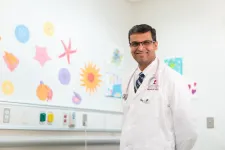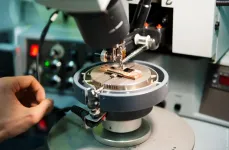(Press-News.org) Atypical teratoid rhabdoid tumor (ATRT) is a rare brain tumor that predominantly occurs in young children. Scientists at St. Jude Children's Research Hospital used data from two clinical trials to study the molecular groups of ATRT and correlate them with clinical outcomes. A paper detailing the findings was published today in Clinical Cancer Research, a journal of the American Association for Cancer Research.
"If you look at the biology of ATRT, we have learned in the last few years that this is not a single disease but instead there are at least three biologically different groups of the same disease," said first and corresponding author Santhosh Upadhyaya, M.D., St. Jude Department of Oncology. "But what are the outcomes for these different groups? That is where the current St. Jude study offers insight into how these different groups of ATRT can present, and what their outcomes may be with different treatment regimens."
There are three previously established molecular groups of ATRT: ATRT-MYC, ATRT-SHH, and ATRT-TYR. Researchers used data from the SJYC07 and SJMB03 clinical trials to look at treatment outcomes from 74 children with ATRT. This is one of the largest cohorts of children with this disease, because ATRT is a rare pediatric cancer.
Findings showed that ATRT-TYR typically occurs in children younger than 3 years old and is less likely to metastasize. They also found that ATRT-SHH tends to occur in very young children and has a higher chance of metastasis at presentation. Additionally, although children with ATRT-TYR had the best overall response, those with ATRT-SHH and ATRT-MYC had comparable treatment responses in the absence of metastases.
The researchers also looked at the SMARCB1 gene in the blood--a hallmark genetic mutation found in ATRT. The scientists showed that approximately a third of tested children have an abnormality in the SMARCB1 gene. These children tend to develop ATRT at a younger age and are more likely to have the ATRT-SHH group. The researchers found that having this abnormality did not predict treatment outcome.
"While we have clearly made giant strides in understanding the molecular basis of ATRT, substantial progress is still required before treatment decisions can be made on the basis of different molecular groups," Upadhyaya said.
Age and metastasis still guide the way
The mortality rate for ATRT is around 70%, and children are typically diagnosed under the age of 3. Age of the child at diagnosis and the extent of metastatic spread remain the two most important factors to consider for prognosis and treatment of this disease.
Children who are older when they are diagnosed and who do not have metastatic spread typically experience the best outcomes. Children under the age of 3 cannot be treated with the radiation therapy offered to older children, which affects outcomes. The researchers stress that children in each group have a chance for a positive outcome, keeping in mind their age and metastatic status.
"Although a better understanding of the molecular groups of ATRT is important for developing the next generation of treatments for this disease, age at diagnosis and metastatic spread are still the most important clinical factors to consider," said senior author Amar Gajjar, M.D., St. Jude Department of Pediatric Medicine chair.
INFORMATION:
The study's other St. Jude authors are Giles Robinson, Arzu Onar-Thomas, Brent Orr, Gang Wu, Catherine Billups, Ruth Tatevossian, Sandeep Kumar Dhanda, Ashok Srinivasan, Ibrahim Qaddoumi, Anna Vinitsky, Gregory Armstrong, Roya Mostafavi, Paul Klimo Jr., Zoltan Patay, Kim Nichols, Frederick Boop, Thomas Merchant and David Ellison. Other authors on the study are Pascal Johann, Hopp Children's Cancer Center Heidelberg and German Cancer Research Center; Marcel Kool of Hopp Children's Cancer Center Heidelberg, German Cancer Research Center and Princess Maxima Center for Pediatric Oncology; Alberto Broniscer, Children's Hospital of Pittsburgh; Anne Bendel, Children's Minnesota; Tim Hassall, Royal Children's Hospital Brisbane; Sonia Partap and Paul Fisher, Stanford University; John Crawford, University of California San Diego and Rady Children's Hospital; Murali Chintagumpala, Texas Children's Cancer Center; Eric Bouffet, the Hospital for Sick Children; Sridharan Gururangan, McKnight Brain Institute, University of Florida; Robert Sanders, Communicare Health Centers; and Daniel Indelicato, University of Florida Health.
The research at St. Jude was funded in part by a grant from the National Institutes of Health (CA21765), and ALSAC, the fundraising and awareness organization of St. Jude.
St. Jude Children's Research Hospital
St. Jude Children's Research Hospital is leading the way the world understands, treats and cures childhood cancer and other life-threatening diseases. It is the only National Cancer Institute-designated Comprehensive Cancer Center devoted solely to children. Treatments developed at St. Jude have helped push the overall childhood cancer survival rate from 20% to 80% since the hospital opened more than 50 years ago. St. Jude freely shares the breakthroughs it makes, and every child saved at St. Jude means doctors and scientists worldwide can use that knowledge to save thousands more children. Families never receive a bill from St. Jude for treatment, travel, housing and food -- because all a family should worry about is helping their child live. To learn more, visit stjude.org or follow St. Jude on social media at @stjuderesearch.
Ticket inspection on public transport can prompt law-abiding people to behave dishonestly once they have gotten off the bus, according to a study published in The Economic Journal. The study was written by three experimental economists: Fabio Galeotti and Marie Claire Villeval of The French National Centre for Scientific Research (CNRS) in the Groupe d'Analyse et de Théorie Economique Lyon St-Etienne (GATE), and Valeria Maggian from Ca' Foscari University of Venice.
In order to study the "side effects" of ticket inspection, researchers designed and carried out a complex large-scale study on public transport and in the streets of Lyon, France. During typical weekdays and avoiding rush hours, ...
- It is as if China is two completely different countries, if we look at how they appear in two such different cases as Africa and the Arctic, says Christer Henrik Pursiainen. He is a professor at the Department of Technology and Security at UiT The Arctic University of Norway.
According to Pursiainen, it is not just the temperature difference that separates Africa from the Arctic. It also provides a good opportunity to take a closer look at how China adapts to two completely different situations and how they use widely differing methods to gain influence.
Together with professors Rasmus ...
Though our galaxy is an immense city of at least 200 billion stars, the details of how they formed remain largely cloaked in mystery.
Scientists know that stars form from the collapse of huge hydrogen clouds that are squeezed under gravity to the point where nuclear fusion ignites. But only about 30 percent of the cloud's initial mass winds up as a newborn star. Where does the rest of the hydrogen go during such a terribly inefficient process?
It has been assumed that a newly forming star blows off a lot of hot gas through lightsaber-shaped outflowing jets and hurricane-like winds launched from the encircling disk by powerful magnetic fields. These fireworks should squelch further growth ...
NEW YORK, NY (March 18, 2021)--Therapies that soothe inflammation could be an effective way to prevent heart disease in people with a common age-related blood condition, according to a new study from researchers at Columbia University Vagelos College of Physicians and Surgeons.
The researchers identified how the blood condition, called clonal hematopoiesis, worsens atherosclerosis, and their findings suggest that an anti-inflammatory drug previously tested in a wider population of people with cardiovascular disease may have potential if used only in those with clonal hematopoiesis.
"The main message from our research is that anti-inflammatory therapies for atherosclerotic heart disease may be particularly effective in patients with clonal hematopoiesis," says Alan Tall, ...
A Russian-German research team has created a quantum sensor that grants access to measurement and manipulation of individual two-level defects in qubits. The study by NUST MISIS, Russian Quantum Center and the Karlsruhe Institute of Technology, published in npj Quantum Information, may pave the way for quantum computing.
In quantum computing the information is encoded in qubits. Qubits (or quantum bits), the quantum mechanical analogue of a classical bit, are coherent two-level systems. A leading qubit modality today superconducting qubits based on the Josephson junction. That is the kind of qubit IBM and Google used in their quantum processors. However, scientists are still searching for the perfect qubit -- the one that can be precisely measured and controlled, ...
Researchers are developing new autonomous technologies that can help people check that isolated elderly family members are okay.
We are living in a world where elderly parents are increasingly distant from their relatives, as many relocate for work opportunities.
There are now more than 4 million people aged 65 and older who are living alone in the UK.
The series of national lockdowns during the coronavirus pandemic has made it even harder for people to check that those elderly loved ones are safe and well.
Families want peace of mind that their elderly relatives are living well, and are maintaining a relatively active lifestyle. Although we can call them to check ...
UNIVERSITY PARK, Pa. -- A team led by researchers in Penn State's College of Agricultural Sciences has developed a diagnostic test that can identify virulent forms of the swine bacterial pathogen Streptococcus equi subspecies zooepidemicus -- often referred to as "Strep zoo" -- which can cause severe illness and death in pigs, other animals and rarely people.
Outbreaks of S. zooepidemicus causing high mortality in swine first were reported in Asia in 1977, and until recently, the pathogen was not thought to be a major concern in North America. However, high-mortality Strep zoo outbreaks occurred in swine herds in Canada, Tennessee, Ohio and Pennsylvania in 2019. Different versions of the pathogen also can cause a range of disease symptoms ...
BOSTON - Patients who regurgitate regularly but without any known cause may have a condition called rumination. Unfortunately, rumination is often confused with other gastrointestinal conditions, which means many patients may not be getting prompt treatment. But a new study by investigators at Massachusetts General Hospital (MGH) in Neurogastroenterology and Motility clearly describes this syndrome, how to distinguish it from other conditions, and how to treat it.
Rumination syndrome is a behavioral problem, in which patients effortlessly and repeatedly regurgitate food into their mouths while eating and sitting upright. It is a learned behavior that is classified as a disorder ...
Announcing a new article publication for BIO Integration journal. In this review article the authors Yingxue Deng, Rui Huang, Songyin Huang and Menghua Xiong from South China University of Technology, Guangzhou, Guangdong, P. R. China and Sun Yat-sen University, Guangzhou, Guangdong, P. R. China discuss how nanoparticles enable efficient delivery of antimicrobial peptides for the treatment of deep infections.
Antimicrobial peptides (AMPs) are rarely directly used to treat deep infections due to their systemic toxicity and low bioavailability. The authors summarize recent progress that researchers employed nanoparticles based delivery systems to deliver AMPs for the treatment of deep infections.
Nanoparticles-based delivery systems offer a strategy ...
(Boston)-- Uncontrolled diabetes increases maternal and fetal risks during pregnancy. As a result, the American Diabetes Association (ADA) recommends that family planning should be discussed and effective contraception should be available to the more than three percent of (more than one million) reproductive-age women in the United States with diabetes. Yet a new study has found that women with diabetes are less likely to use contraception after their diabetes diagnosis.
"Efforts are needed to ensure that women with diabetes receive the counseling and clinical services needed to carefully plan their pregnancies," said corresponding author Mara Murray Horwitz, MD, assistant ...



